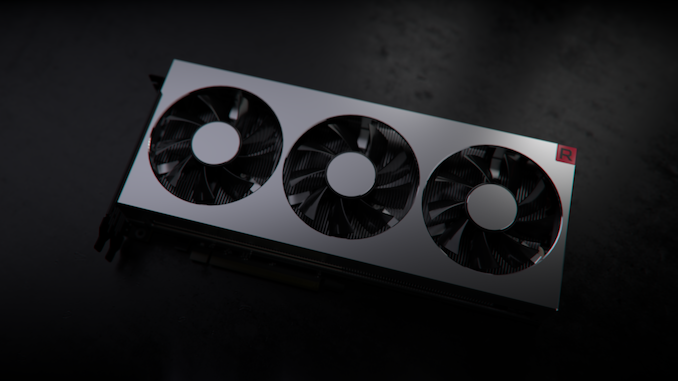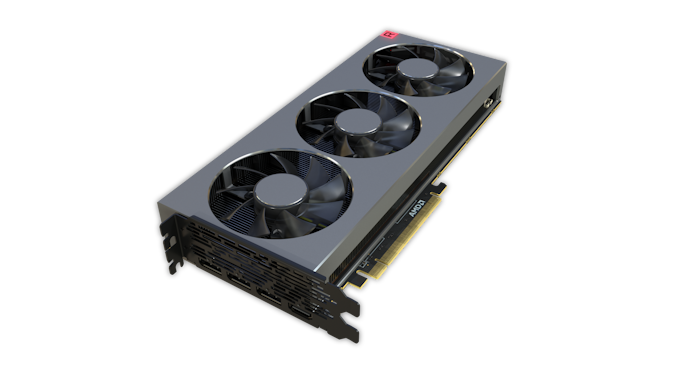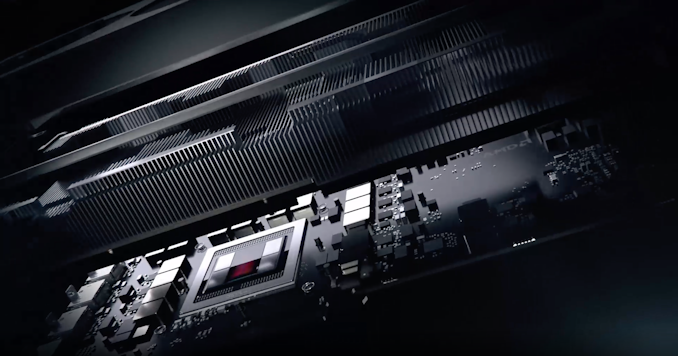The AMD Radeon VII Review: An Unexpected Shot At The High-End
by Nate Oh on February 7, 2019 9:00 AM ESTMeet The Radeon VII
First things first is the design and build, and for the AMD Radeon VII, we've already noticed the biggest change: an open air cooler. Keeping the sleek brushed metal look of the previous RX Vega 64 Limited Edition and Liquid variants, they've forgone the blower for a triple axial fan setup, the standard custom AIB configuration for high-end cards.
While NVIDIA's GeForce RTX series went this way with open-air dual-fan coolers, AMD is no stranger to changing things up themselves. Aside from the RX Vega 64 Liquid, the R9 Fury X's AIO CLC was also quite impressive for a reference design. But as we mentioned with the Founders Edition cards, moving away from blowers for open-air means adopting a cooling configuration that can no longer guarantee complete self-cooling. That is, cooling effectiveness won't be independent of chassis airflow, or lack thereof. This is usually an issue for large OEMs that configure machines assuming blower-style cards, but this is less the case for the highest-end cards, which for pre-builts tend to come from boutique system integrators.
The move to open-air does benefit higher TDP, and at 300W TBP the Radeon VII is indeed one for higher power consumption. While 5W more than the RX Vega 64, there's presumably more localized heat with two more HBM2 stacks, plus the fact that the same amount of power is being consumed but on a smaller die area. And at 300W TBP, this would mean that all power-savings from the smaller process were re-invested into performance. If higher clockspeeds are where the Radeon VII is bringing the majority of its speedup over RX Vega 64, then there would be little alternative to abandoning the blower.
Returning to the Radeon VII build, then, the card naturally has dual 8-pin PCIe connectors, but lacks the BIOS switch of the RX Vega cards that toggled a lower-power BIOS. And with the customary LEDs, the 'Radeon' on the side lights up, as does the 'R' cube in the corner.
In terms of display outputs, there are no surprises here with 3x DisplayPort and 1x HDMI.
A few teardowns of the card elsewhere revealed a vapor chamber configuration with a thermal pad for the TIM, rather than the usual paste. While lower-performing in terms of heat transfer, we know that the RX Vega cards ended up having molded and unmolded package variants, requiring specific instructions to manufacturers on the matter. So this might be a way to head off potential ASIC height difference issues.














289 Comments
View All Comments
drgigolo - Saturday, February 9, 2019 - link
Yeah, of course I am looking at it that way :-) But I also like tech, and find the progress lacking these last years. Longer development cycles and diminishing returns for a lot more dollars.remedo - Thursday, February 7, 2019 - link
Why isn't there any benchmarks for machine learning or deep learning?imaheadcase - Thursday, February 7, 2019 - link
Because the card is not for that...loleva02langley - Thursday, February 7, 2019 - link
It kind of is... it is a Radeon Instinct M150 with less memory.DigitalFreak - Thursday, February 7, 2019 - link
The buy a Radeon Instinct M150GreenReaper - Thursday, February 7, 2019 - link
Sure, if you want to pay two and a half times as much! Maybe get two and blow the rest on juice.eva02langley - Friday, February 8, 2019 - link
Well, you are buying a Vega 20 gimped... >:/So you do in reality... >:/
Ryan Smith - Thursday, February 7, 2019 - link
In short, ML results take longer to put together than these relatively short embargoes allow for. It's also not a primary market for this card, so other things such as gaming performance testing get priority.That said, we're curious about it as well. Now that we're past the embargo, check back in later this month. We have an RTX Titan review coming up, which will give us a great opportunity to poke at the ML performance of the Radeon VII as well.
eva02langley - Friday, February 8, 2019 - link
I will be curious to see that. Compute/ML/Rendering/Content Creation comparison. I was more looking for this in all honesty since we knew what to expect from the card from the beginning.HStewart - Thursday, February 7, 2019 - link
I would think this is expected, AMD trying there best to go against NVidia video and probably release because some of struggles that RTX is having with unit issues.But in stage in my life, personally I don't need a high end graphics card but I would go nVidia because of past good experience. But in any case how many owners actually need high end card. For majority 90+ % of people Integrated graphics are good enough for spreadsheets, internet and word processing